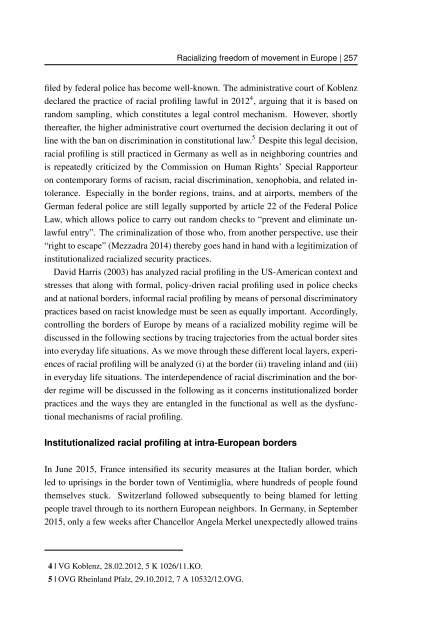movements
1gaMtN8aD
1gaMtN8aD
Erfolgreiche ePaper selbst erstellen
Machen Sie aus Ihren PDF Publikationen ein blätterbares Flipbook mit unserer einzigartigen Google optimierten e-Paper Software.
258 | Inga Schwarz<br />
to carry refugees from Hungary through Austria and into Germany, security controls<br />
were intensified on train connections between Germany and Austria as well as on car<br />
traffic at the German-Austrian border. This growing trend to control intra-European<br />
borders has been justified by the rising number of asylum seekers and by the politics<br />
of security following the terrorist attacks in Paris in November 2015.<br />
In fall, while writing this article, the politics and practices of securing Europe from<br />
within proceeded at a rapid pace. Hungary built a fence along the border with its<br />
EU-neighbor Croatia, which led to an immediate discussion of whether Croatia too<br />
should build a fence on its southern borders. Slovenia and Austria likewise considered<br />
following Hungary’s example on their southern borders. Germany, in the<br />
meantime, started to control the German-Austrian border extensively and discussed<br />
building ‘transit zones,’ 6 where incomers would be held in camps at the border while<br />
an accelerated procedure would verify their claim for asylum and deport those whose<br />
asylum petition for Germany was rejected. 7<br />
I witnessed the impacts of these tightened control procedures when I revisited people<br />
on their continuing migratory journeys in Italy. Initially, I met these migrants<br />
in Germany, before they were deported back to Italy because of the Dublin III regulation,<br />
8 went there to renew Italian documents, or to reconnect with their social<br />
networks. During my fieldwork, I witnessed several incidents of racialized border<br />
control at intra-European borders, whose existence is frequently forgotten by ‘white’<br />
Central Europeans. On the Italian-French border as well as on the Italian-Swiss border,<br />
intense controls were carried out in trains entering the respective nations from<br />
Italy. At both sites, border guards strode through the trains and, using racial profiling,<br />
asked people of color for passports. Or, without even doing so, they just commanded,<br />
“Out!” to those who fell under their paradigm of suspicion. Phenotypic categories<br />
served as first order categories of suspicion in those cases and were accompanied by<br />
differentiation based on gender, class, and age. Young men of color thus became<br />
victims of the most intense scrutiny, whereas blond females like myself were on the<br />
opposite end of the spectrum of suspicion.<br />
6 | Interior Secretary Thomas de Maizière (CDU – Christian Democratic Union) presented a<br />
respective draft law to establish transit zones in October 2015.<br />
7 | At the same time, the German asylum law was tightened in October 2015 and the list of<br />
so-called ‘safe countries of origin’ was extended by adding countries like Kosovo, Albania, and<br />
Montenegro.<br />
8 | The Dublin III regulation (Regulation (EU) No 604/2013 of the European Parliament and<br />
of the Council of 26 June 2013) obliges the countries of first entry into the European Union to<br />
conduct the asylum procedures of the respective newcomers.


